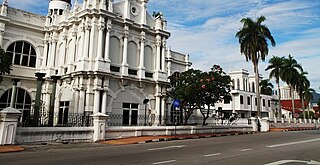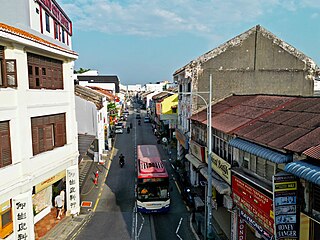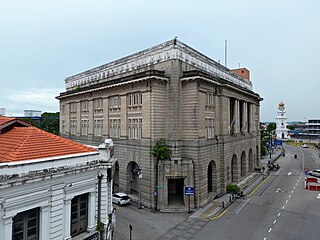
George Town is the capital of the Malaysian state of Penang. It is the core city of the George Town Conurbation, Malaysia's second largest metropolitan area with a population of 2.84 million and the second highest contributor to the country's GDP. The city proper spans an area of 306 km2 (118 sq mi) encompassing Penang Island and surrounding islets, and had a population of 794,313 as of 2020.

Francis Light was a British Royal Navy officer and explorer best known for founding the colony of Penang and its capital city of George Town in 1786. Light was the father of William Light, who founded the city of Adelaide in South Australia in 1836.

The Penang State Assembly Building is the home of the Penang State Legislative Assembly. It is located at Light Street in the city of George Town in Penang, Malaysia, within the city's UNESCO World Heritage Site. All State Legislative Assembly proceedings are held within the building.

The architecture of Penang reflects the 171 years of British presence on the island, coalescing with local, Chinese, Indian, Islamic and other elements to create a unique and distinctive brand of architecture. Along with Malacca, Penang is an architectural gem of Malaysia and Southeast Asia. Unlike Singapore, also a Straits Settlement, where many heritage buildings had to make way for modern skyscrapers and high-rise apartments due to rapid development and acute land scarcity, Penang's architectural heritage has enjoyed a better fate. Penang has one of the largest collections of pre-war buildings in Southeast Asia. This is for the most part due to the Rent Control Act which froze house rental prices for decades, making redevelopment unprofitable. With the repeal of this act in 2000 however, property prices skyrocketed and development has begun to encroach upon these buildings, many of which are in a regrettable state of disrepair. The government in recent years has allocated more funding to finance the restoration of a number of derelict heritage buildings, most notably Suffolk House, City Hall and historic buildings in the old commercial district.

Penang Road is a major thoroughfare in the city of George Town within the Malaysian state of Penang. It runs between Farquhar Street to the north and Komtar to the south. The road is a one-way road, with the traffic directed southwards towards Komtar.

The State of Penang, one of the most developed and urbanised Malaysian states, is located at the nation's northwest coast along the Malacca Strait. Unlike most Malaysian states, the history of modern Penang was shaped by British colonialism, beginning with the acquisition of Penang Island from the Sultanate of Kedah by the British East India Company in 1786. Developed into a free port, the city state was subsequently governed as part of the Straits Settlements, together with Singapore and Malacca; the state capital, George Town, briefly became the capital of this political entity between 1826 and 1832. By the end of the 19th century, George Town prospered and became one of the major entrepôts in Southeast Asia.

The City Hall is the local government headquarters of George Town within the Malaysian state of Penang. Built by the British, it now serves as the seat of the Penang Island City Council and was previously the seat of the George Town City Council.

The Suffolk House refers to two early residences built on the same site located some four miles west of George Town, Penang, Malaysia. Located on the banks of the Air Itam River, the earliest of the two buildings is notable for having served as the residence of Francis Light, the founder of the first British settlement on Penang. Following Light's death in 1794, and with Penang becoming the fourth presidency of India in 1805, a newer Suffolk House replaced the original house, assuming multiple roles before it was later neglected and subsequently restored.

Edwardian architecture usually means a Neo-Baroque architectural style that was popular for public buildings in the British Empire during the Edwardian era (1901–1910). Architecture up to 1914 is commonly included in this style.

The Penang State Museum and Art Gallery is a museum and art gallery in George Town, Penang, Malaysia.

Beach Street is a major thoroughfare in George Town within the Malaysian state of Penang. Part of the city's central business district, it is also one of the oldest streets in Penang, having been created soon after the founding of the state by Captain Francis Light in 1786.

The George Town Central Business District (CBD) is the financial and political centre of the city of George Town, the capital of the Malaysian state of Penang. The financial district, which was first envisioned by the Penang Island City Council's Local Plan 2030, lies entirely within the city centre, and is home to much of the city's banking and financial services. The term CBD is often used interchangeably with Downtown George Town, encompassing both the historic core and modern sections of the city centre.

Light Street is the oldest road in the city of George Town within the Malaysian state of Penang. It was named after the founder of Penang, Captain Francis Light. As the epicentre of George Town, the street was created soon after Light established the settlement in 1786 and has been serving as a major thoroughfare within the city centre ever since.

Chulia Street is one of the oldest roads in the city of George Town within the Malaysian state of Penang. Created soon after the founding of George Town in 1786, it forms a part of the city's Little India enclave ever since, whilst also boasting a multicultural character due to Indian Muslim and Chinese influences.

Farquhar Street is a major thoroughfare in the city of George Town within the Malaysian state of Penang. Created in the late 18th century, the road forms part of the city centre's civic precinct, and is notable for the colonial buildings built under British rule. These include some of the most significant civic, religious, and commercial buildings of Penang, such as Penang High Court, Penang State Museum and Art Gallery, St. George's Church, Church of the Assumption, and Eastern & Oriental Hotel.

MBf Tower is a commercial skyscraper within George Town in the Malaysian state of Penang. Located at Northam Road within the city's Central Business District (CBD), the 31-storey building, completed in 1994, is one of the oldest skyscrapers along the coastal street.

George Town, the capital city of the state of Penang, is the second largest city in Malaysia and the economic centre of the country's northern region. The history of George Town began with its establishment by Captain Francis Light of the British East India Company in 1786. Founded as a free port, George Town became the first British settlement in Southeast Asia and prospered in the 19th century as one of the vital British entrepôts within the region. It briefly became the capital of the Straits Settlements, a British crown colony which also consisted of Singapore and Malacca.

The Port of Penang is a deepwater seaport within the Malaysian state of Penang. It consists of terminals along the Penang Strait, including five in Seberang Perai and one in George Town. The Port of Penang was the third busiest harbour in Malaysia in terms of cargo as of 2017, handling 1.52 million TEUs of cargo, as well as the busiest port-of-call within the country for cruise shipping.

The Standard Chartered Bank building is a historical building in George Town within the Malaysian state of Penang. Completed in 1930, the office building, situated at Beach Street within the city's Central Business District (CBD), was one of the tallest in the city at that time. It served as the Penang branch of Standard Chartered until 2017, after which the bank relocated to its new premise down the street. The building has since been reopened as Spaces Beach Street, one of IWG's coworking spaces in Malaysia.

The HSBC Building is a historical building in George Town within the Malaysian state of Penang. Opened in 1951, the office building, situated at Downing Street within the city's Central Business District (CBD), houses the Penang branch of HSBC.





















